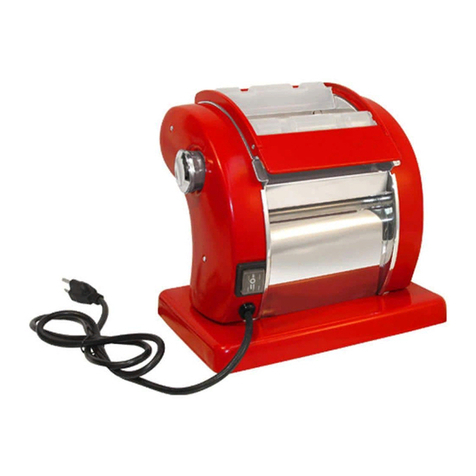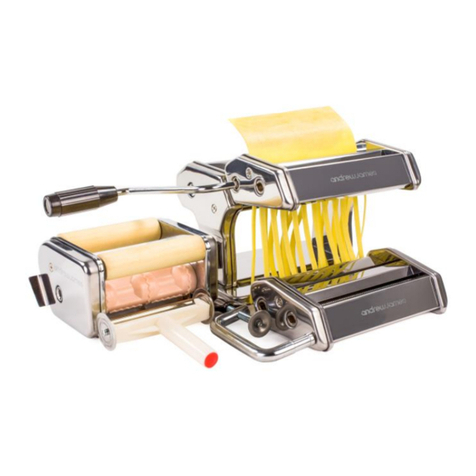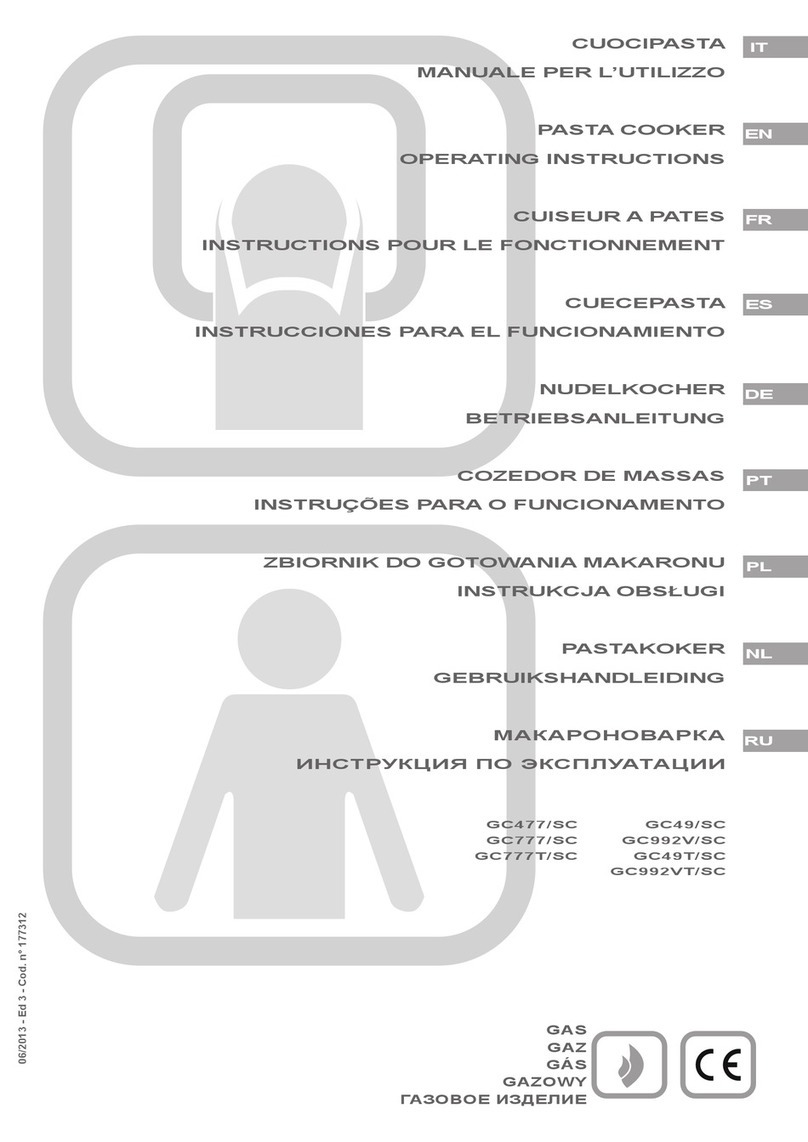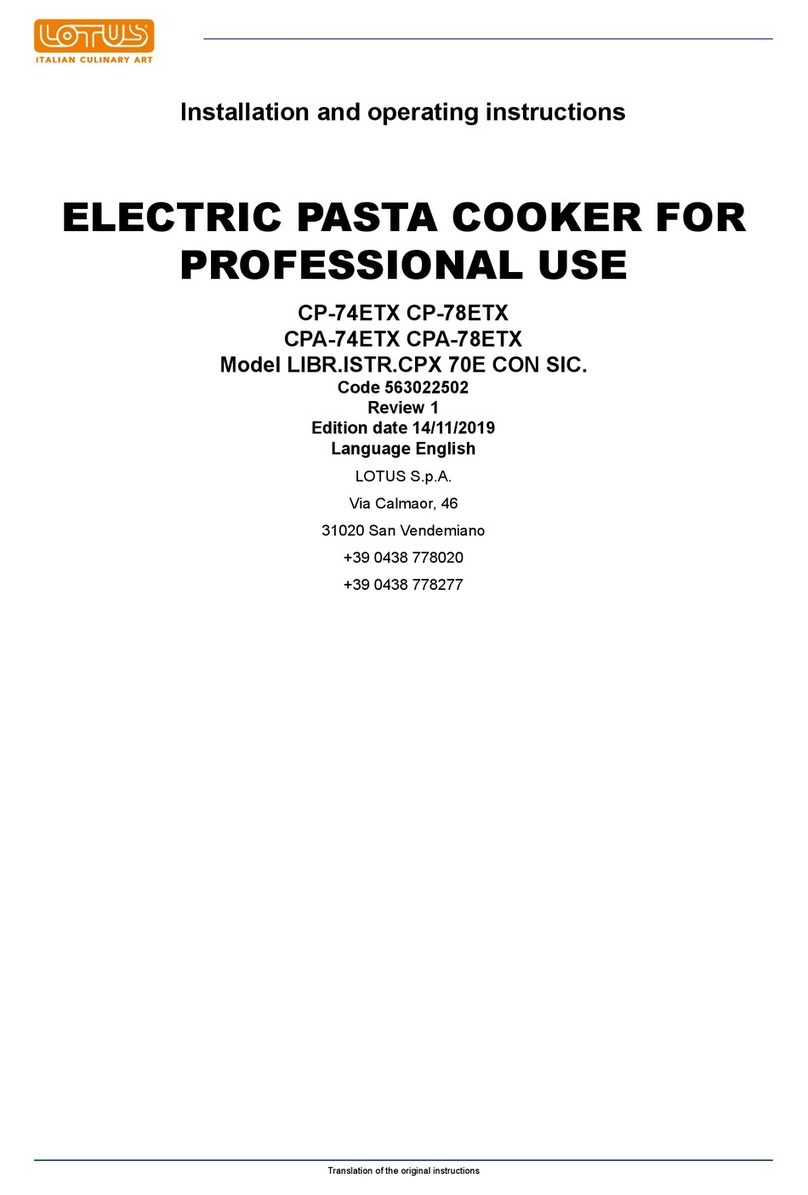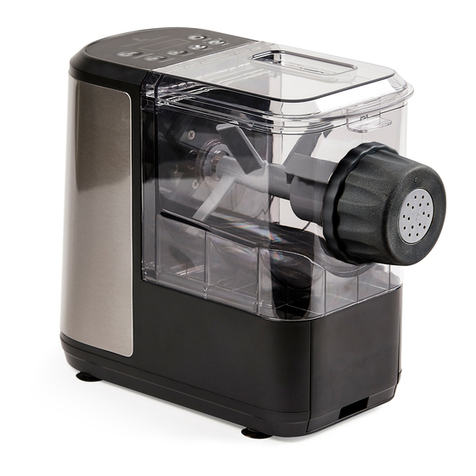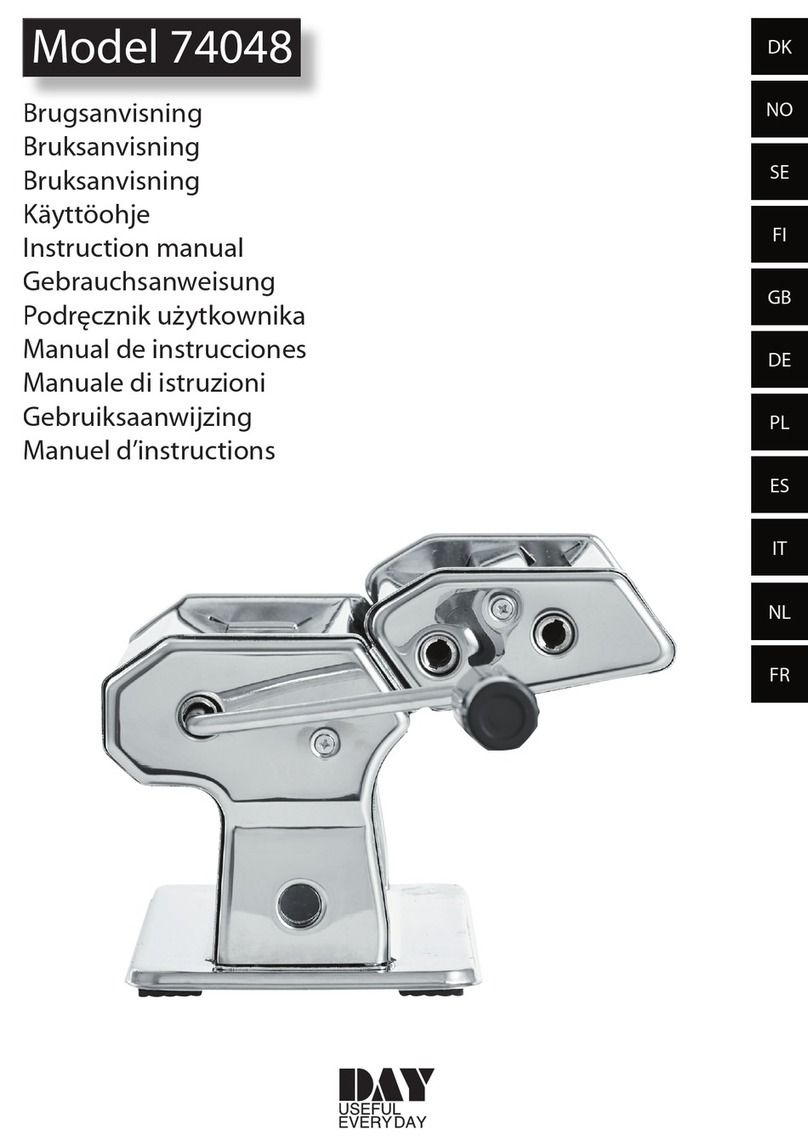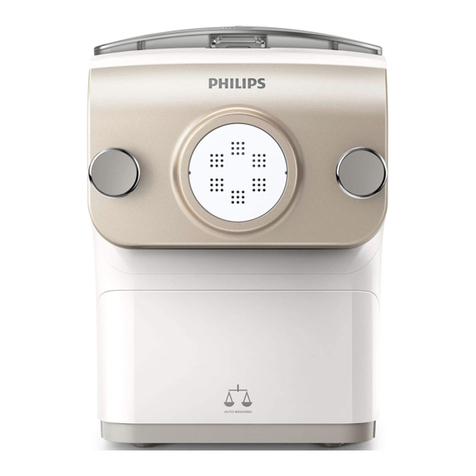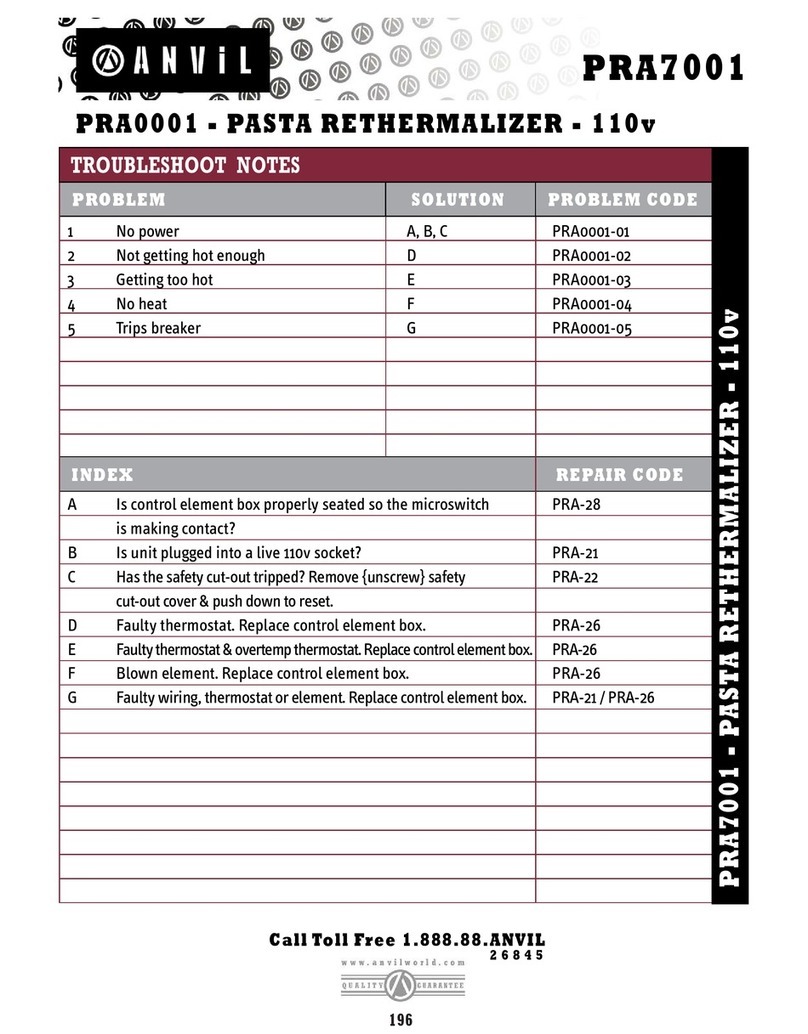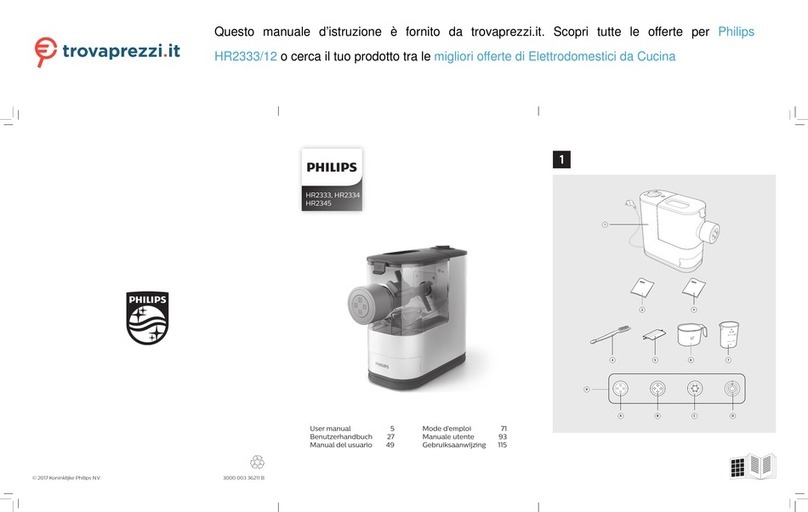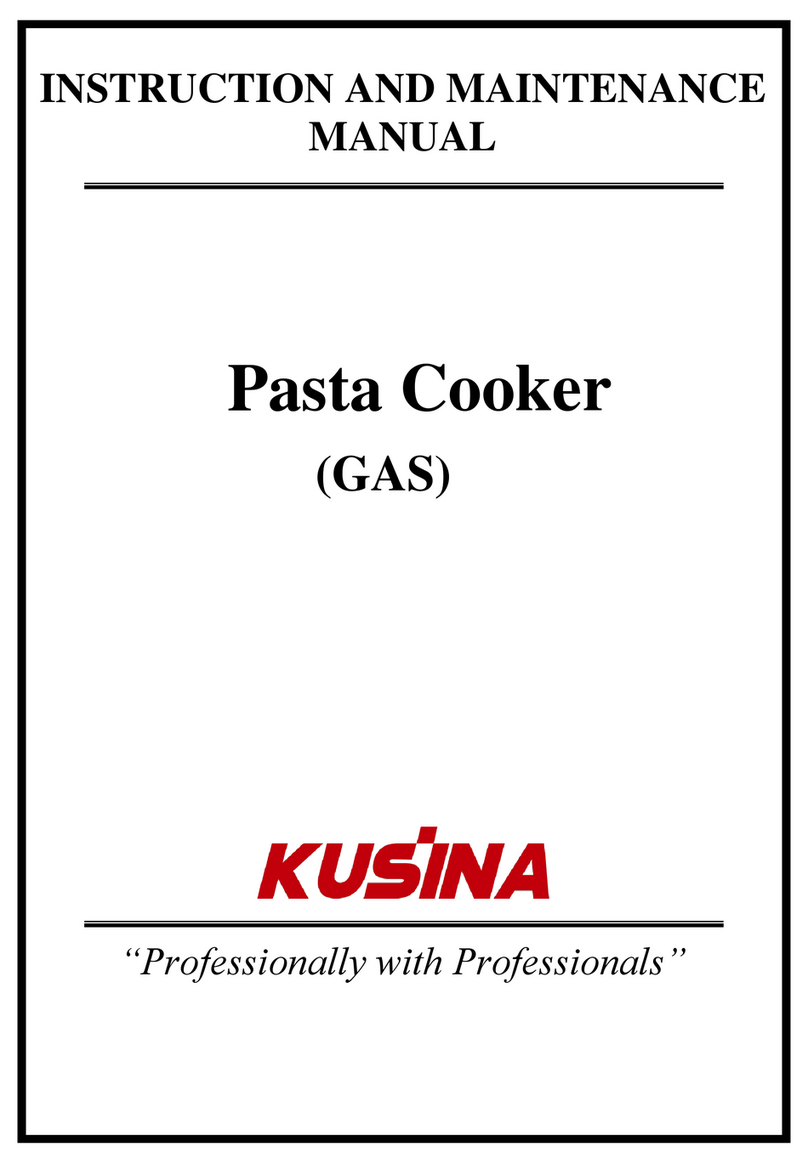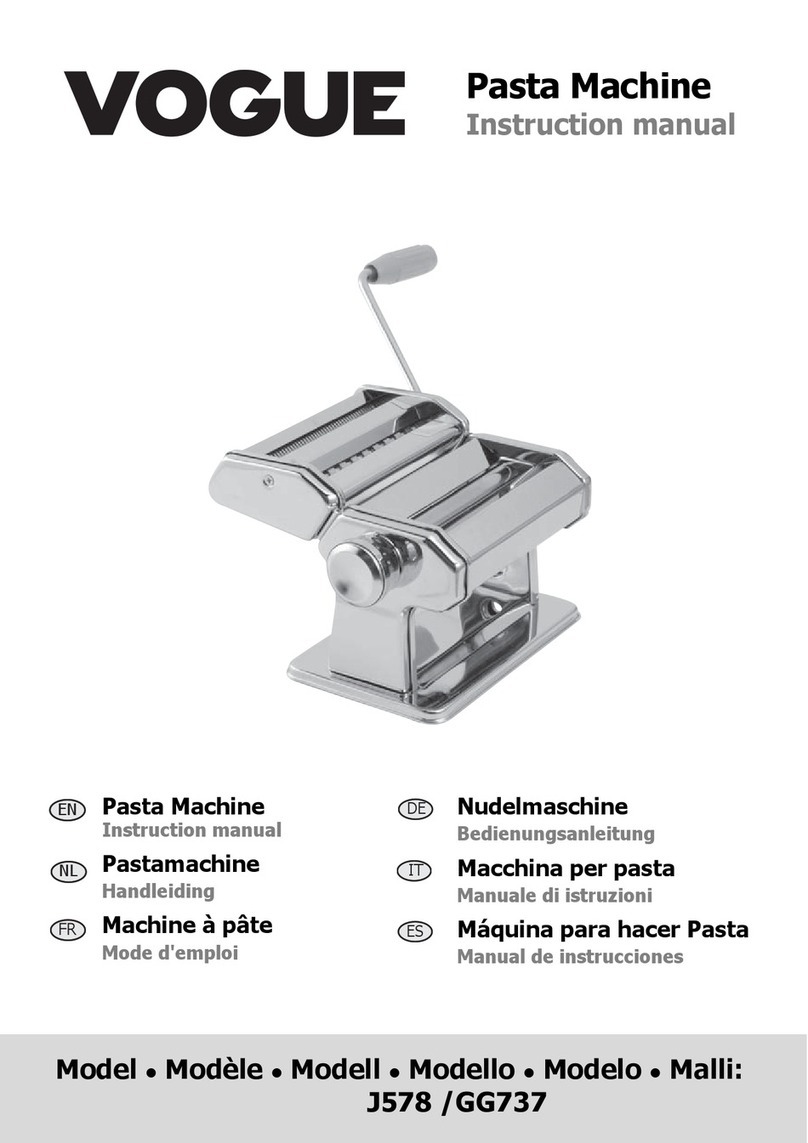Giorik 2CPG Service manual

01/2020
Rev.1_07/2023
ENGLISH: Installation, Use and Maintenance Manual
EN - GAS PASTA COOKER
CPG726 - 2CPG
CPG746 - 22CPG
CPG926 - 3CPG
CPG946 - 23CPG

2

3
Contents
1. INSTALLATION 5
1.1 General and safety warnings .............................................5
1.2 Positioning ........................................................................9
1.3 Equipotential ...................................................................10
1.4 Smoke exhaust ................................................................10
1.5 Water connection.............................................................10
1.7 Gas Connection ................................................................11
1.8 Transformation for use with Dierent Gas .......................13
1.8.1 Replacement of the main burner nozzle .....................13
1.8.2 Main Burner Primary Air Regulation ...........................14
1.8.3 Replacement of the Pilot Burner Nozzle .....................14
1.8.4 Adjusting the reduced ow rate .................................15
2. GENERAL INSTRUCTIONS FOR USE 17
2.1 Commissioning ................................................................17
2.2 Switching on and o ........................................................18
2.2.1 Lighting the pilot........................................................19
2.2.2 Turning on the main burner .......................................19
2.2.3 Turning o the main burner .......................................19
2.2.4 Turning o completely ...............................................19
2.3 Draining ..........................................................................19
3. MAINTENANCE and CLEANING 20
3.1 Cleaning ..........................................................................20
3.2 Maintenace ......................................................................21
3.3 Spare Parts ......................................................................21
4. TECHNICAL SPECIFICATIONS 22
5. DISPOSAL OF THE APPLIANCE 24

4

5
1. INSTALLATION
1.1 General and safety warnings
• Read this manual
carefully before installing
and operating the devices
because the text provides
important information about
safety for their installation,
use and maintenance.
• Keep the manual in a
location that can be easily
accessed by the operators
for further consultation.
• Always include the manual if
the appliance is transferred;
if necessary, request a new
copy from the authorised
dealer or directly from the
manufacturer.
• The instructions can also be
requested by the customer
in electronic format and
are available on the
manufacturer’s website.
• For appliances weighing
more than 50 Kg, use
suitable devices for handling.
• As soon as the packaging
is removed, make sure
the appliance is in good
condition and there is no
damage caused during
transportation. Never
install or use a damaged
appliance; if in doubt,
contact the after-sales
technical assistance or your
local dealer immediately.
• As the packaging
material is potentially
dangerous, it must be kept
out of the reach of children
or animals and disposed of
correctly in compliance with
local regulations.
• Installation must be
performed in compliance
with the mandatory
regulations of the country of
installation.
• For gas appliances, the gas
supply tubing or hose shall
comply with the national
requirements in force
and shall be periodically
examined and replaced as
necessary.

6
• The appliances connected
to a potable water supply
(temporarily o permanently)
shall be installed in
accordance with national
regulations.
• Before installing the
equipment, check that the
systems are compliant with
the regulations in force
in the country of use and
with that stated on the
information plate axed to
the appliance.
• Installation or
maintenance dierent
to those indicated in the
manual can cause damage,
injury or fatal accidents.
• Installation, extraordinary
maintenance and repair
operations on the equipment
must only be performed
by professionally qualied
personnel and following the
manufacturer's instructions.
• During assembly of the
equipment, anyone not
involved with the installation
should not pass through or
remain in the working area.
• The appliance was designed
to cook foodstus in
indoor environments and
must only be used for this
function. Any dierent use
must therefore be avoided
as it is considered improper
and dangerous.
• The appliance must only
be used by personnel who
have been appropriately
trained in its use. To avoid
the risk of accidents or
damage to the equipment,
it is essential that personnel
are constantly trained with
regard to safe operation.
• The device must not be used
by persons with impaired
physical, sensory or mental
capacities or by persons with
no experience or relevant
knowledge.
• The appliance must
be placed in a suitably
ventilated room to prevent
the excessive accumulation
of harmful substances in the
air.
• Children must be supervised
to ensure they neither play

7
with nor use the appliance.
• During operation it is
necessary to pay attention
to the hot areas of the
external surface of the
appliance which, in operating
conditions, can even exceed
60°C.
• The use of hearing protection
is not necessary as the
sound pressure level of the
appliance is lower than 70
dB(A).
• In the event of failure
or malfunctioning, the
equipment must be
deactivated; any repairs
must only be performed
by an assistance centre
authorised by the
manufacturer and original
spare parts must be used.
• Interventions, tampering or
modications not expressly
authorised, which do not
respect that stated in this
manual, will make the
warranty null and void.
• Do not deposit or use
ammable substances near
the equipment.
• In the event of prolonged
non-use of the appliance,
the gas must be turned o.
• Before commissioning the
appliance, make sure that
all parts of the packaging
have been removed,
ensuring they are disposed
of in compliance with current
legislation.
• Any changes to appliance
installation that become
necessary must be
approved and performed by
authorised technicians.
• The appliance is intended
for professional use only.
• Failure to comply with the
previous warnings can
compromise both your
safety and the safety of the
equipment.
• ATTENTION! The oor
near the appliance must not
be slippery.
• The technical plate, axed

8
to the appliance, provides
important information: this
is essential if interventions
must be requested for
maintenance or repairs of
the appliance; therefore,
it must not be removed,
damaged or modied.
• After installation, it is
recommended to set-up
a scheduled maintenance
plan (at least once a year),
performed by qualied
personnel.
• The equipment complies
with the requirements of
Regulation EU 2016/426.
• Theequipmentcomplieswith
the essential requirements
of the Machinery Directive
2006/42/EC.
• The appliance complies with
the essential requirements
of the 1935/2004 EC
regulation regarding contact
with foodstus.

9
1.2 Positioning
The appliance was designed to be installed in enclosed spaces. It cannot
be used outdoors and must be exposed to atmospheric agents.
The place designated for the installation of the appliance must have a rigid,
level and horizontal surface, which must be able to safely support the weight
of the appliance (approx. 150 kg) and the load at maximum capacity.
The appliance must be transported to the place of
installation on its wooden pallet and handled using
precautions to prevent over-turning.
The appliance must be positioned at least 20
cm from the adjacent walls (Fig.1); in case of
ammable walls, these must be suitably protected.
All of the materials used for packaging are
compatible with the environment, they can be
stored without danger or be disposed of according
to local regulations.
Remove the appliance from the packaging and inspect it for damage, then
position it in the place of use.
Ensure the appliance rests on a level oor
and adjust the height via the levelling feet
as shown in Fig 2.
Signicant unevenness or inclinations can
compromise the operation of the oven.
The oor of the premises where the
appliance is installed must be re-proof.
Remove the entire protective lm from the external panels of the appliance,
detaching it slowly to remove all traces of adhesive.
Make sure that all openings and holes designed for heat intake/discharge
are not obstructed.
Do not block the intake or heat dissipation openings and vents and place
the appliance beneath an extractor hood whose system must be legally
compliant.
200
200
Fig. 1

10
1.3 Equipotential
The appliance must be included within an equipotential system
whose eciency is checked in compliance with the standards in
force.
For the connection use the clamp, placed on the frame and
marked with the symbol Fig.3.
If the appliance is installed in the vicinity of other household
appliances, ensure the electrical cables and pipes are suciently
distanced from the hot parts of the same.
Make sure that around the appliance there is sucient air circulation.
1.4 Smoke exhaust
The machine must always be installed under a fume hood.
For proper installation, make sure that the following guidelines are followed:
• consider that the air needed for burner
combustion is 2 m³/h per kW of the installed
rated output;
• the gas supply to the appliance must be
controlled directly by this system and must
cut out whenever the ow rate drops below
the values prescribed;
• the gas must only be re-admitted to
the appliance manually;
• the end part of the appliance evacuation
pipe must be positioned inside the base
perimeter projection of the hood (Fig.4).
1.5 Water connection
The device is supplied with a ½” coupling for direct connection to the water
mains and a connecting hose compliant with the IEC 61770 standard.
Appliances must be installed in accordance with EN 1717 and the national
water regulation in force.
Installation of the appliance must be done using the hose set supplied. If
the installation involves replacing existing equipment, the connection hoses
used must be changed.
Fig. 4
Fig. 3

11
The maximum water pressure allowed is 6 bar.
The appliance must be supplied with drinking water for correct installation
and operation.
The water inlet pipe must be connected to the mains water
supply with a shut-o valve (example Fig.5), which can be
easily closed when the pasta cooker is not in use or requires
maintenance.
A mechanical lter must be installed between the cock and the appliance in
order to prevent the entrance of ferrous particles which, on oxidising, could
corrode the pan.
Before coupling the last stretch of piping, it is recommended to allow the
water to ow through in order to eliminate any ferrous residues inside the pipe.
Appliances connected to a potable water supply (temporarily or permanently)
shall be installed in accordance with national regulations.
1.6 Connection of the drain
The water drain must ow into an open siphon so that there is no contact
between the appliance drain and the siphon as established by the hygiene
standard in force.
There must be one drain for every appliance.
The drain pipe must be resistant to high temperature.
1.7 Gas Connection
Check on the technical plate (Fig.6)
located inside the cabinet, on the lower left
side, that the appliance has been tested and
approved for the type of gas available to the
user.
Make sure the nozzles installed upstream of
the appliance correspond to the type of gas
that is available.
Check the data on the technical plate to
make sure that the pressure reducer capacity
is sucient for the appliance supply.
The appliance has been set in the factory
Fig. 5
Fig. 6
CAT
G30
G31 G20 G25
COUNTRY
A �
TYPE
MOD
NR
II
II
II
II
II
II
I
I
I
I
2H3+
2H3B/P
2E+3+
2ELL3B/P
2H3B/P
3+
2E+
2E3+
3B/P
2E
ΣQn kW
G30 G20 G25
kg/h m³/h m³/h
Pmbar
Pmbar
Pmbar
Pmbar
Pmbar
Pmbar
Pmbar
Pmbar
Pmbar
Pmbar
28-30
28-30
28-30
28-30
30
50
30
30 30
50 50
50
37
37
37
37 20
20
20
20
20
20
20
20/ / /
/ /
/
/ / 25
/ /
20
25
/
/
/
IT - ES - IE - PT
GB - GR - CH
LT - DK - FI - EE- NO
LY - CZ - SK - SI - SE
FR
AT - CH
CY - BE
DE
BE
LU
MT - IS - HU - CY
PL
PRDISPOSTO A GAS - PREVU A GAZ
PRESET FOR GAS - EINGSTELLT AUF GAS
PREDISPUESTO A GAS - PREDISPOSTO À GÀS
mbar
V Hz kW IP EN 203-1
MADE IN ITALY
CAT
II
2EK3B/P
m³/h
Pmbar
G30
G31 G20 G25
G25.3
COUNTRY
NL
30 30 / 2520
G25.3
A

12
for use with G20 gas at a pressure of 20 mbar, unless requested dierently on
placing the order.
Do not reduce the diameter of the section
between the reducer and the appliance.
Fit a gas lter above the pressure
adjuster in order to ensure optimum
operation.
Connect the appliance to a special
gas pipe with an internal diameter of at
least 16 mm for G1/2” connections and
a diameter of at least 20 mm for G3/4”
connections.
The pipe may be xed or exible and the coupling can be in metal.
Length shall not exceed 1,5 m.
Gas supply tubing or hose shall comply with the national requirements in
force and shall be periodically examined and replaced as necessary.
Make sure that the exible metal connection pipe to the gas tting does not
touch overheated parts and that it cannot be twisted. Use fastening clamps
and sealing gaskets in compliance with the installation standards. Envision
cocks or drain valves with an internal diameter no smaller than the coupling
pipe mentioned above. After connecting the pipe to the gas mains, make sure
that the joints and couplings have no leaks. To do this, use soapy water or
specic foamy product to identify the leaks.
NEVER USE NAKED FLAMES!
Control of the Nominal Heat Input:
During initial installation and during maintenance or adaptation to another
type of gas nominal heat input must be measured. It can be measured
using the volumetric method with the aid of a litre counter or chronometer.
The appliance must be supplied
with one of the types of gas whose
properties and pressure are set
out in Tab. 1.
GAS TYPE PRESSURE IN
mbar.
NOM MIN
G20 NATURAL GAS 20 18
L.P.G. G30/31 29/37 25/25
Table 1
GASKET SEAL
GAS INTAKE RAMP
HOSE

13
Checking Gas Pressure:
The supply gas pressure must be measured at
the height of the pressure outlet (Fig.7) after
removing the seal screws.
Use a exible pipe, connect a gauge to the
pressure point (e.g. a liquid manometer with
minimum resolution of 0.1 mbar) and measure
the inlet pressure whilst the appliance is operating.
The pressure value must not be less than the
minimum limit indicated in Tab. 1.
If the pressure value is not correct, contact the gas supplier for the
adjustment (it may be necessary to adjust the system pressure regulators).
Disconnect the pressure gauge, close the sealing screw without forgetting
to insert the washer and ensure that there are no leaks.
1.8 Transformation for use with Dierent Gas
If the appliance must be connected to a dierent type of gas than that for
which it has been prepared, the nozzles must be replaced.
This operation must be performed by qualied sta.
Proceed as follows.
1.8.1 Replacement of the main burner nozzle
Fig. 7
AFig. 8

14
• Close the gas valve upstream of the appliance
• Open the door or doors.
• unscrew the nozzle (Ref.A-Fig.8) and replace it with the one
corresponding to the gas chosen as indicated on the technical plate.
The nozzles are marked in hundredths of a millimetre.
1.8.2 Main Burner Primary Air Regulation
• loosen the xing screw (Ref.A) of the
primary air regulation bush (Ref.B);
• position the bush (Ref.B) at the
distance "X" according to the type of
gas installed (see the technical data
table under the "primary air regulation”
item);
• tighten the xing screw (Ref.C);
• seal the adjusted component using
paint to prevent any tampering.
NOTE: the primary air is deemed correctly adjusted, when it can be
safely guaranteed that the ame does not go out with cold burner and
no ashback occurs with hot burner.
1.8.3 Replacement of the Pilot Burner Nozzle
Fig. 9
B
C
1
2
3
4
Fig. 10

15
To replace the pilot nozzle, proceed as follows:
• Close the gas valve upstream of the appliance;
• open the door or doors;
• unscrew the spark plug nut (Fig.10 - Ref.1);
• unscrew the screw-on cap (Ref.2);
• remove the nozzle (Ref.3) and replace it with the one for the
type of gas chosen;
• put the screw cap and spark plug back on;
• check the tightness of the cap using the foaming product.
1.8.4 Adjusting the reduced ow rate
Remove the knob and adjust the minimum or by-pass screw (Fig.11-
Ref.1): the burner must not go out or have a ashback when rapidly
passing from the maximum to minimum position. To operate with LPG,
the screw must fully tightened.
Check that the ame is stable, especially after rapid manoeuvres on high.
If the burner goes out or the ame is too high, adjust it as explained above.
Fig. 11
1

16
When conversion or adaptation has been completed for every type of
gas, it is MANDATORY to ax the corresponding plate above the technical
plate, which is provided along with the nozzles.
Once the operations for the gas type conversion have been completed,
check the seal of the dismantled parts with the soap water test or with
the foam solution indicated.
NEVER USE NAKED FLAMES!
WARNING:
THE MANUFACTURER IS NOT RESPONSIBLE AND WILL NOT
COVER UNDER GUARANTEE DAMAGE CAUSED BY INCORRECT
INSTALLATION NOT FOLLOWING THE INSTRUCTIONS.

17
2. GENERAL INSTRUCTIONS FOR USE
2.1 Commissioning
This appliance allows you to cook food (pasta, rice, etc.) in boiling water through
the use of perforated baskets (Fig.12).
Any other use should be avoided as it is considered improper and dangerous.
During operation, supervise the appliance.
The water temperature is not regulated by a thermostat.
The temperature is adjustable choosing the intensity of the ame (MIN and
MAX) rotating the gas tap.
In case of accidentally ignition of the appliance with empty basin, safety
thermostat trips switching OFF the pilot ame and the main burner.
The reset of the safety
thermostat is automatic.
It is recommended not to turn
ON the appliance with empty
basin.
It is recommended to completely
turn OFF the appliance (also pilot
ame) at the end of the use.
Before starting up the appliance
for the rst time, remove all
the packaging material. Then,
thoroughly clean the industrial
protection grease from the
Water
inlet
Level
mark
Overow
drain
Basket
Fig.12
Fig.13
Safety
Thermostat
Thermostat
Bulb

18
baskets, basket supports (on the bottom of the tank) and basket support rack
(on the top) which can be washed in the dishwasher (the baskets must be
thoroughly rinsed and dried after washing) and the tank as follows:
• open the water top on the front panel (Fig.14) and ll
the tank up to the overow hole with water and normal
detergent, start the appliance, bring the water to the boil
and allow it to boil for a few minutes;
• drain the water through the drain valve
(Fig.15) and rinse the tank thoroughly using
clean water and then dry well.
2.2 Switching on and o
Before switching on the pasta cooker, ll the tank via the relevant tap (Fig.14),
on the control panel, up to the level mark (Fig.12).
Appliance shall not be used empty.
Warning! The pasta cooker will not switch if there is no water in the tank.
Never use rock salt because it if does not circulate and dissolve completely, it
could deposit on the bottom of the tank and cause corrosion in the long term.
We recommend, therefore, only using table salt (max. 3 mm grain size) and to
add it after the water boils.
Then, switch on as follows.
O
Pilot
Large ame
Small ame
Fig.16
Fig.14
Fig.15

19
2.2.1 Lighting the pilot
Open the gas valve upstream of the appliance.
Open the cabinet door(s).
Press and turn the knob (Fig.16) to the pilot position while repeatedly pressing
the piezoelectric ignition button (located inside the cabinet (Fig. 13) until the
pilot is lit.
2.2.2 Turning on the main burner
When the pilot is lit, light the main burner by turning the knob to the “large
ame” position.
To adjust the temperature and ame to a minimum, turn the knob to the “small
ame”.
We recommend bringing the water to the boil with the knob in the “large ame”
position and then, turning it down based on the load.
Warning!
Top up the level of the water so that it does not fall below the level mark.
Every tank has an overow (Fig.12); it is located under the basket support
rack in the front part of the top. Ensure that the drain hole is always free and
clean.
When cooking food, the baskets should test on the rack on the bottom of the
tank (Fig.17).
2.2.3 Turning o the main burner
It is only possible to switch o the main burner by turning the knob to the pilot
ignition position.
In this way, only the pilot burner remains on.
2.2.4 Turning o completely
If, instead, the knob is taken to the "O" position, the pilot burner also switches
o in addition to the main burner.
Close the water and gas taps upstream of the appliance.
2.3 Draining
To drain the content of the tank, open the tap (Fig.15) located inside the cabinet.
The water automatically ows out of the appliance into the drain pipe through

20
an open siphon. If necessary, place a metal container under the appliance that
is big enough to collect all the water in the tank.
Watch out for splashes of boiling water!
3. MAINTENANCE and CLEANING
Before doing any cleaning, close the gas shut-o valve upstream of the
appliance.
3.1 Cleaning
At the end of the working day, clean the appliance, both for reasons of hygiene
and to prevent operating faults.
The appliance must never be cleaned with direct or high-pressure jets of
water. Moreover, the appliance should not be cleaned with wire sponges,
ordinary steel brushes or scrapers; eventually, and only for the steel parts, you
can use stainless steel wool, wiping the appliance in the direction of the sheet
metal grain.
The inside of the pan must be cleaned with hot
water and washing-up liquid.
Avoid using chlorine-based detergents.
It must never be cleaned using steel wool,
sandpaper or similar. If heavily soiled, the use
of synthetic sponges is recommended (e.g.
Scotchbrite).
Clean the lter on the bottom of the tank above
the drain as well (Fig.17).
Every week, we recommend cleaning the
drain with a plastic brush (e.g. like those used
for cleaning bottles) to prevent deposits from
building up.
After cleaning, rinse with clean water.
Baskets, basket supports and lter can be washed in the dishwasher.
Warning! After washing, the baskets must be thoroughly rinsed and
dried.
Fig.17
This manual suits for next models
7
Table of contents
